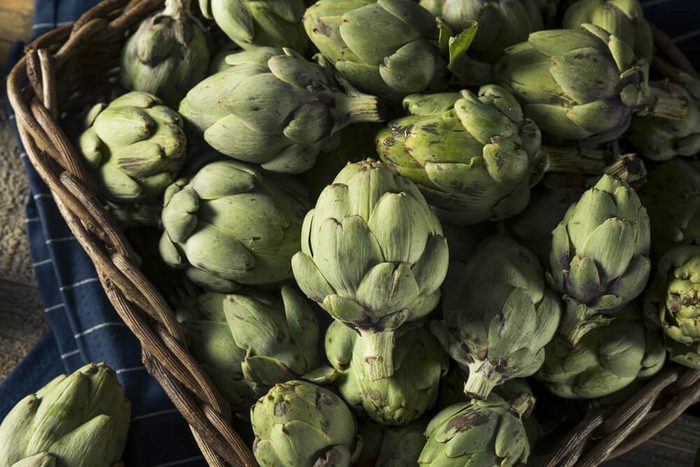
Artichoke
Fruits and vegetables are the cornerstone of any healthy eating or weight loss plan, but they can also be challenging if you’re looking to curb your hunger. After all, if you’re starving soon after eating them, you’ll be less likely to stick to your goals. So which fill you up best? The secret is in the fiber. “Fiber helps keep us feeling fuller longer. It slows gastric emptying, keeping food in our stomach as it breaks down,” says Bridget Murphy, MS, a registered dietitian at NYU Langone Medical Center.
“The average American consumes only about 12 grams of fiber per day. That’s less than half the recommendation of 25 to 30 grams of fiber per day for women, and 30 to 35 grams for men,” notes Murphy. One fiber-filled veggie she recommends is artichoke—one cup of artichoke hearts has nearly nine grams! Discover potential medical reasons you’re always hungry.
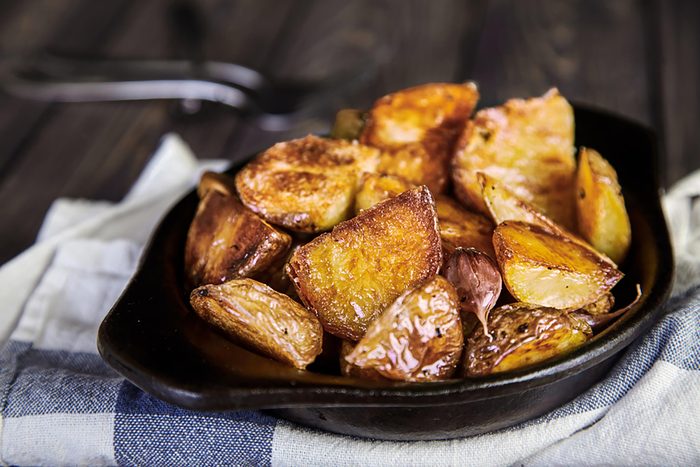
Potato
One filling veggie that’s undeservedly gotten a bad rap over the years is the potato. “This vegetable receives a lot of criticism for contributing to weight gain,” says Jeanne Piga-Plunkett, RD, co-director of the Dietetic Internship Program at The University of Texas Health Science Center at Houston (UTHealth). But that’s because there’s a tendency to fry spuds or douse them in butter or sour cream.
Prepare them without all the additives and they can be healthy and fill you up with fiber. “Fiber contributes to that feeling of fullness and satiety,” Piga-Plunkett says. A 2018 study found that when overweight or obese women ate less-energy-dense foods—including potatoes—early in the day, they dropped weight and kept it off. Researchers suspect this is because the women stayed full throughout the day without relying on high-calorie alternatives.
Sweet potatoes are low on the glycemic index but still high in fiber, Piga-Plunkett says. Or, try butternut squash. “It’s low calorie—100 grams equals 45 calories—and is an excellent source of fiber,” she says. On the other hand, these 20 foods are never worth the calories.
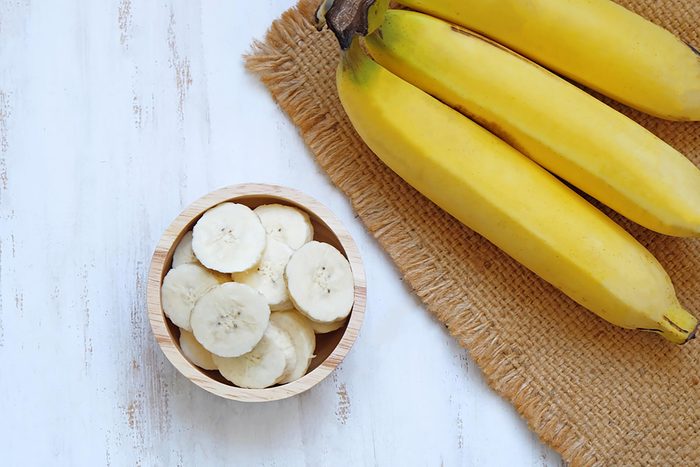
Banana
Bananas are great for recharging your body, and even come in their own handy packaging to grab and go. One 2012 study even found that bananas were just as good at refueling athletes as sports drinks. Plus, they offered extra nutritional benefits such as extra vitamins and minerals and fiber.
Bananas are higher in calories than other fruits, but they hold unique benefits as a filling snack. “Rich in fiber, slightly green bananas contain a source of resistant starch which is slower digested, promoting fullness,” says Erin Palinski-Wade, RD, CDE, author of Belly Fat Diet for Dummies. Resistant starch isn’t digested by the body, so it fills you up without turning into fat.
In a 2015 study from Skidmore College, women who ate foods with resistant starch and protein burned more fat and felt fuller than those who ate regular starch and protein. If you want a sweeter taste, go for a browner banana, Piga-Plunkett says. “It has been rumored that bananas have some form of fat contributing to satiety, but when reviewed, it is less than one percent,” she says.
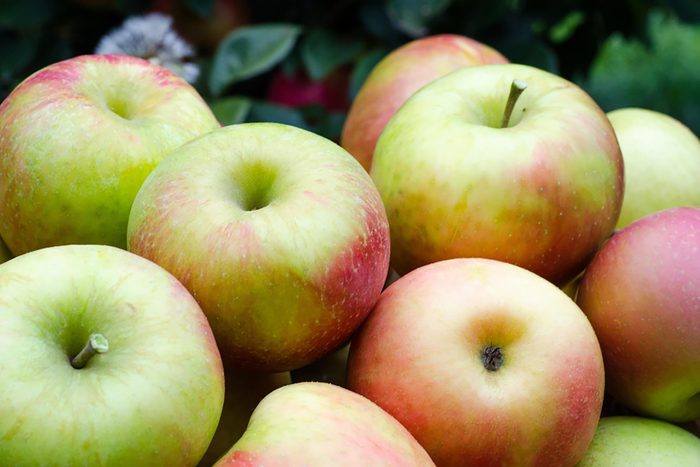
Apple
The old adage about apples keeping the doctor away just might be true, so eat up. “Apples provide a combination of fiber and water that allows them to promote a feeling of fullness,” Palinski-Wade says.
Apples also contain pectin, a soluble fiber which satisfies hunger. “Soluble fiber dissolves in water and will form a gel material known as pectin,” says Lucy Lengfelder, a clinical dietician at The University of Texas Health Science Center at Houston (UTHealth). “It helps to lower your cholesterol and decrease your blood glucose level.” Soluble fiber is found in oats, legumes, and some fruits and veggies—but most contain insoluble fiber instead (which aids bowel health), so apples are a bit unique in this way.
A 2018 analysis in the Journal of the American College of Nutrition found apples were linked with weight loss, possibly due to their high amounts of polyphenols, which likely have anti-obesity effects. Palinski-Wade suggests crunching apples slowly, as eating slowly promotes fullness. Have leftover apples? This healthy baked apple recipe is simple irresistible.
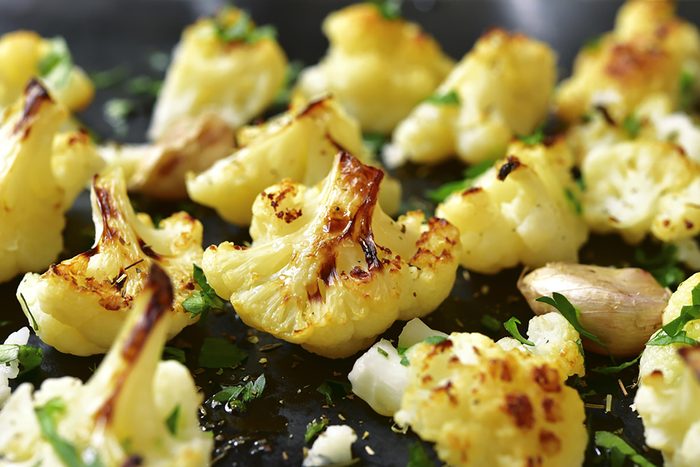
Cauliflower
Cauliflower is a replacement for everything from rice to pizza crust with good reason: It’s a healthier, filling substitute. You can roast it, boil it, mash it or add it to dishes to increase vegetable intake, says Piga-Plunkett. “It can be added frozen to smoothies, increasing fiber and a feeling of fullness without much flavor changes.”
The veggie is also a good source of vitamins C, K, and folate, she says. “As a cruciferous vegetable, the high fiber content of cauliflower promotes fullness as it slows digestion,” Palinski-Wade says. Research from 2015 published in the European Journal of Cancer found that white vegetables, along with fruits and foods rich in vitamin C, offered a reduction in heart disease risk and even cancer.
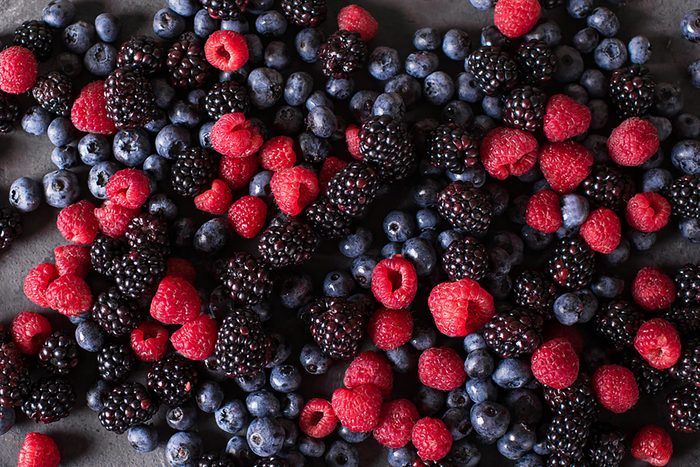
Berries
These little poppers make the perfect snack, and it’s hard to go overboard on them. “A comment you will never hear is that I gained weight eating five servings of fresh fruits,” says Lengfelder. So replace your evening snack of chips or pretzels with a bowl of berries. Because they’re not high in calories, you can eat more of them. Plus substituting for calorically dense foods will aid in weight reduction.
Berries like blueberries and blackberries are also “high in phytochemicals and antioxidants, which prevent inflammation at the cellular level,” Lengfelder says. Berries may also protect against diabetes and cardiovascular disease, making them a great choice for dessert. Here are more foods that are even healthier than you realized.
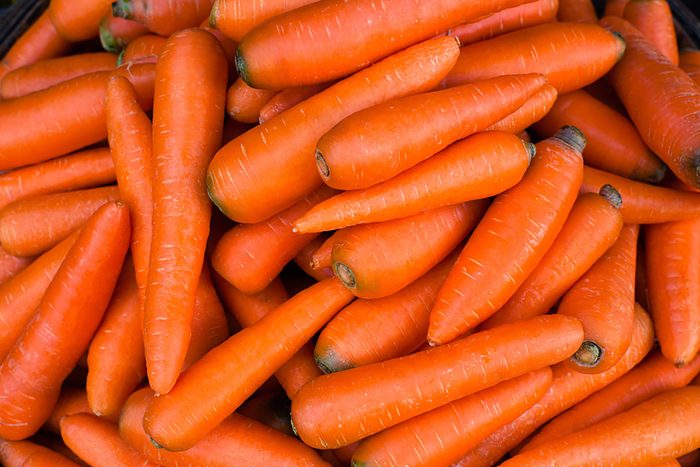
Carrots
Carrots are a filling, satisfying snack—they’re sweet without being high in sugar. And because they’re crunchy, they won’t get smushed in your bag if you’re on the go. “The fiber content of carrots provides a feeling of fullness with few calories,” Palinski-Wade says.
In recipes, carrots fill you up and increase the nutritional content of your meal with fewer calories. “They can add both flavor and fiber when pureed and included in recipes such as hummus, tomato sauces, and chilies,” Piga-Plunkett says.
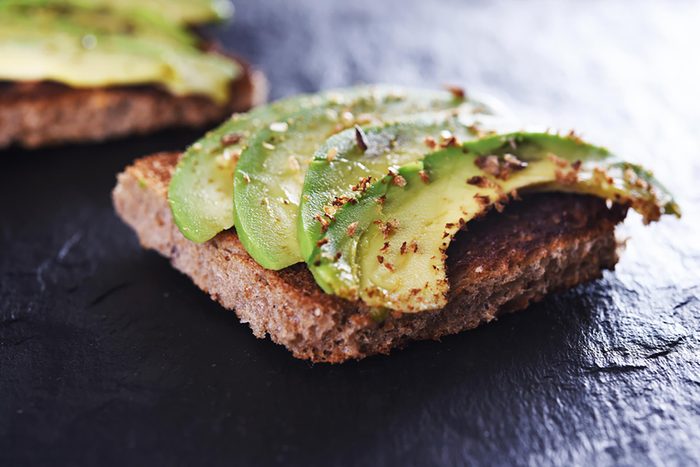
Avocado
Avocados are probably the most hunger-satisfying of all healthiest fruits and veggies, partly because they do contain more calories—240 a cup. But, they’re a good way to stay fuller longer with healthy fats. “Replacing saturated fat with unsaturated fat [as is found in avocado] increases feeling of fullness, and can lower cholesterol levels,” Lengfelder says. Just make sure you’re not eating it with unhealthy chips!
As part of a good diet, “research has found that the addition of half an avocado to a meal increased satiety and lessened the desire to eat after a meal, without elevating blood glucose levels,” Palinski-Wade says. Although they calorically denser, they are also nutrient dense—so fullness is combined with the body getting what it needs, giving you a natural signal to stop eating before you overdo it. Read up on these other tricks to eat healthier without trying.
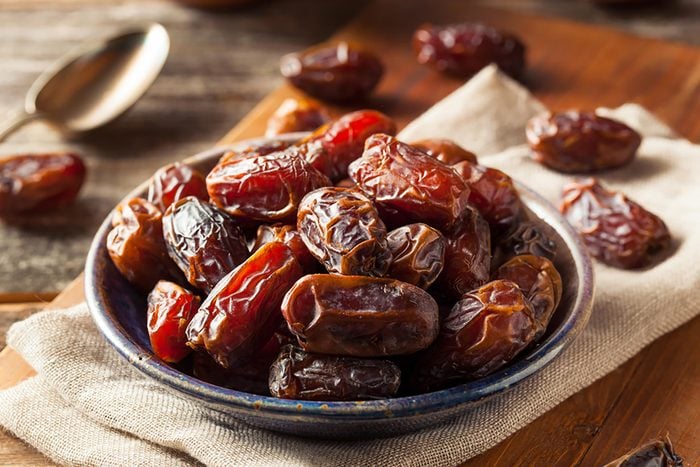
Dates
Dates are an exotic, sweet treat with health benefits. They do contain a lot of calories and natural sugar—but also lots of fiber. For this reason, Palinski-Wade says they’re a filling substitute to make desserts healthier. “Dates are a great way to enhance the sweetness of a recipe without added sugar,” she says. “Swapping out added sugars for dates can increase the fiber content of a recipe while reducing the amount of refined carbohydrates. This change may slow down how quickly the food is digested, promoting an increased feeling of satiety when compared to recipes rich in added sugars.” Check out these other healthy-eating secrets that nutritionists use themselves.
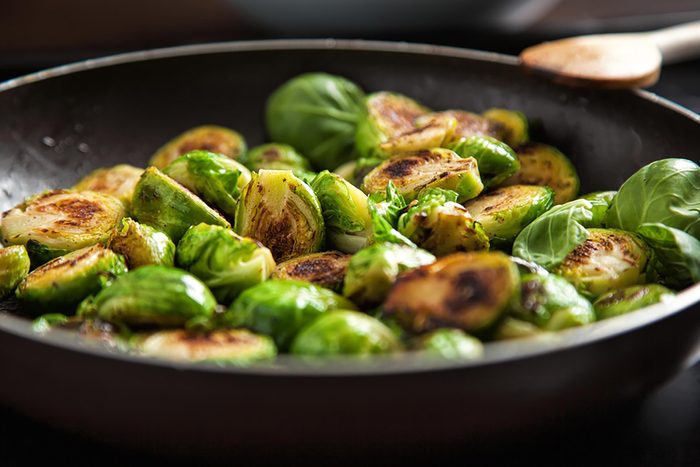
Brussels sprouts
Like its relative cauliflower, Brussels sprouts are a satisfying side dish. “Brussels sprouts are rich in fiber, which promotes fullness as well as lower cholesterol levels,” Palinski-Wade says.
Another benefit for your tummy: Brussels sprouts are an antioxidant-rich food, protecting our GI system and sustaining intestinal immune function, Piga-Plunkett says. However, eating too many may have unpleasant side effects. “Brussels sprouts can leave people feeling bloated and gassy, so be careful of volume,” Murphy says. The cruciferous veggies also happen to be one of these healthiest green vegetables you can eat.
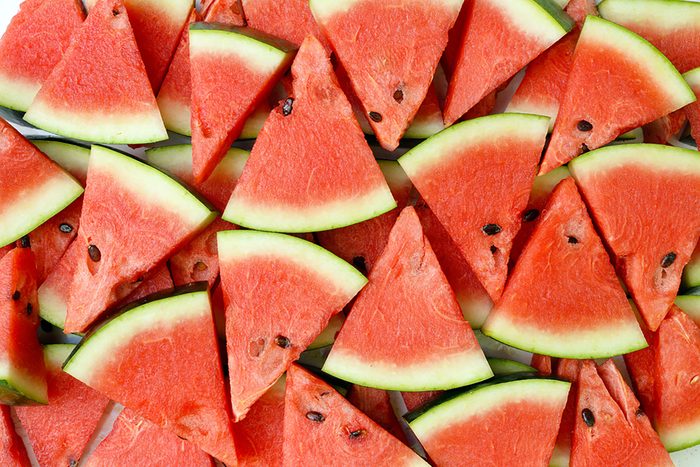
Watermelon
Who doesn’t love the juiciness of a ripe watermelon? All that liquid is a great way to keep you feeling fuller. Just like drinking a glass of water can make you less hungry, so can chowing down on this fruit. “Watermelon is over 94 percent water,” Palinski-Wade says. “This excess volume of fluid promotes fullness without many additional calories.”
Watermelon is also a great source of vitamins A and C, and potassium. “Watermelon contains lycopene, which is an antioxidant carotenoid,” Lengfelder says. “It can contribute to reducing heart disease and various cancers.” A 2014 study from Florida State also showed it lowers blood pressure. It doesn’t have much fiber, but you can eat a lot of it because it’s so low in calories. So feel free to indulge—and the more you eat, the more fiber you get.
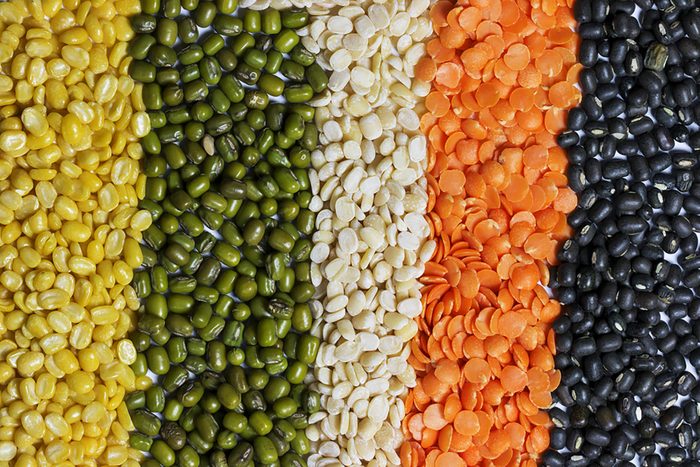
Pulses
You might not have heard of “pulses,” but you’ve definitely eaten them. Technically vegetables, pulses are legumes including beans, chickpeas, lentils, and dried peas. “Pulses have eight grams of filling protein per half-cup serving, cooked—that’s double the protein of quinoa, making pulses one of the best sources of plant-based protein,” Palinski-Wade says.
The combination of protein and fiber in pulses also makes them one of the most filling vegetable options there is. According to a 2019 study from the journal Sports, pea protein helped athletes engaged in HIIT training for 8 weeks gain just as much strength as those who consumed whey protein.
A 2016 review of research found that pulses helped people lose weight and keep it off, likely because of these hunger-satisfying properties. Plus, they have other health benefits, too. “A diet rich in pulses may reduce cholesterol levels, and the risk of heart disease, certain cancers, and even lower the risk of obesity,” Palinski-Wade says. Now that you know which foods are the most filling, make sure you stay away from these “healthy” foods that nutritionists won’t touch.

